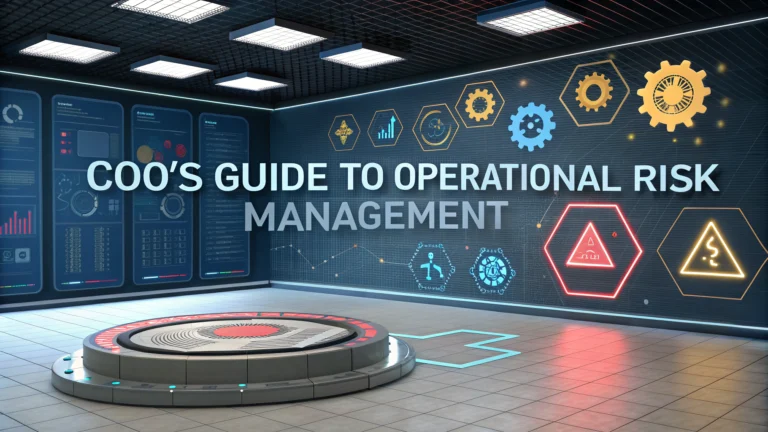Risk management represents one of the most significant responsibilities for Chief Operating Officers across industries.
This guide explores essential operational risk management strategies, tools, and frameworks that COOs can implement to protect their organizations.
Understanding and managing operational risks effectively can mean the difference between organizational resilience and potentially devastating disruptions.
Key Components of Operational Risk Management
- Risk identification and assessment
- Control implementation and monitoring
- Business continuity planning
- Incident response procedures
- Compliance management
Risk Assessment Framework
Every effective risk management strategy starts with a structured assessment process.
| Risk Category | Assessment Methods | Monitoring Frequency |
|---|---|---|
| Process Risk | Process mapping, control testing | Monthly |
| People Risk | Skills assessment, turnover analysis | Quarterly |
| Systems Risk | IT audits, penetration testing | Bi-annual |
Implementing Control Measures
Strong internal controls form the foundation of risk mitigation.
- Preventive Controls: Access restrictions, approval processes, segregation of duties
- Detective Controls: Monitoring systems, reconciliations, audit trails
- Corrective Controls: Incident response plans, backup systems, insurance coverage
Technology Solutions for Risk Management
Modern risk management requires robust technological support.
- GRC Platforms: ServiceNow GRC, MetricStream
- Risk Analytics Tools: IBM OpenPages, SAP Risk Management
- Monitoring Systems: Tableau, Power BI for risk dashboards
Building a Risk-Aware Culture
Employee engagement in risk management significantly improves organizational resilience.
- Regular training programs
- Clear communication channels
- Risk reporting incentives
- Leadership involvement
Measuring Risk Management Effectiveness
Regular assessment of risk management programs ensures continuous improvement.
- Key Risk Indicators (KRIs)
- Control effectiveness metrics
- Incident response times
- Risk mitigation success rates
Next Steps for Risk Management Success
Contact professional risk management organizations for additional guidance and certification:
- RIMS (Risk and Insurance Management Society): www.rims.org
- IRM (Institute of Risk Management): www.theirm.org
- GARP (Global Association of Risk Professionals): www.garp.org
Regulatory Compliance and Reporting
Organizations must maintain robust compliance frameworks to meet evolving regulatory requirements.
- Industry-specific regulations
- Cross-border compliance requirements
- Regular compliance audits
- Documentation and reporting protocols
Crisis Management Integration
Effective risk management frameworks must incorporate crisis response capabilities.
- Emergency Response: Immediate action protocols
- Crisis Communication: Stakeholder management plans
- Business Recovery: Restoration procedures
- Lessons Learned: Post-incident analysis
Supply Chain Risk Management
Modern organizations must actively manage supply chain vulnerabilities.
- Vendor assessment frameworks
- Supply chain mapping
- Alternative supplier strategies
- Geographic risk distribution
Emerging Risk Considerations
Future-focused risk management must address evolving threats.
Key Areas of Focus:
- Cybersecurity threats
- Climate-related risks
- Geopolitical uncertainties
- Technological disruptions
Strengthening Organizational Resilience
Risk management success requires continuous evolution and adaptation.
- Regular framework reviews
- Updated risk assessments
- Enhanced stakeholder engagement
- Proactive risk mitigation strategies
Advancing Risk Management Excellence
Organizations must commit to ongoing development of their risk management capabilities.
- Invest in advanced risk management technologies
- Develop specialized risk management expertise
- Foster cross-functional collaboration
- Maintain industry best practices
FAQs
- What are the key responsibilities of a COO in managing operational risk?
A COO is responsible for developing risk management frameworks, implementing internal controls, overseeing risk assessment processes, establishing risk tolerance levels, and ensuring compliance with regulatory requirements while maintaining operational efficiency. - How should a COO approach Enterprise Risk Management (ERM)?
COOs should implement a comprehensive ERM framework that includes risk identification, assessment, mitigation strategies, monitoring systems, and regular reporting mechanisms while aligning with the organization’s strategic objectives. - What are the essential components of an operational risk assessment?
Key components include identifying potential risks, analyzing probability and impact, evaluating existing controls, determining risk appetite, assessing business continuity plans, and documenting risk matrices and heat maps. - How can a COO effectively manage third-party vendor risks?
Through implementing robust vendor due diligence processes, establishing performance metrics, conducting regular audits, maintaining clear contractual agreements, and developing contingency plans for vendor-related disruptions. - What role does technology play in operational risk management?
Technology enables automated risk monitoring, real-time reporting, data analytics for risk prediction, incident tracking systems, and integrated governance, risk, and compliance (GRC) platforms. - How should COOs handle cybersecurity risks?
By implementing comprehensive cybersecurity frameworks, ensuring regular security assessments, maintaining incident response plans, conducting employee training, and coordinating with IT teams for security measures. - What are the key metrics for monitoring operational risk?
Essential metrics include Key Risk Indicators (KRIs), loss event data, near-miss incidents, control effectiveness measures, regulatory compliance scores, and operational efficiency metrics. - How can COOs ensure effective crisis management and business continuity?
Through developing comprehensive business continuity plans, establishing crisis management teams, conducting regular drills, maintaining emergency communication protocols, and ensuring critical business function resilience. - What regulatory compliance aspects should COOs focus on?
COOs must ensure compliance with industry-specific regulations, maintain documentation, conduct regular audits, update policies and procedures, and stay informed about regulatory changes. - How should COOs approach operational risk reporting to the board?
By providing clear, concise risk dashboards, highlighting key risk trends, presenting mitigation strategies, sharing incident reports, and maintaining transparent communication about risk status.
